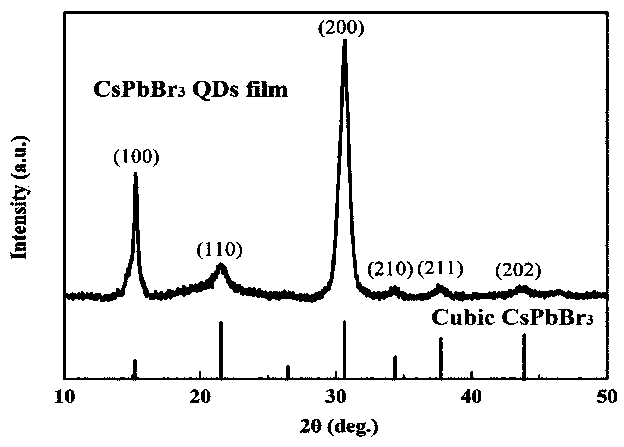CsPbBr3 quantum dot-silicon based composite structure solar cell
A technology of solar cells and composite structures, applied in the field of solar cells, can solve the problems of complex preparation process, price and cost, environmental problems, etc., and achieve the effects of high light absorption rate, controllable film formation parameters, and enhanced short-wave response
- Summary
- Abstract
- Description
- Claims
- Application Information
AI Technical Summary
Problems solved by technology
Method used
Image
Examples
Embodiment 1
[0028] Such as figure 1 Shown is CsPbBr of the present invention 3 Synthesis process of quantum dot-silicon-based composite structure solar cell In this process, in this example, first prepare CsPbBr applied on the surface of the silicon substrate of the solar cell 3 Colloidal quantum dots: the specific process is: under vacuum conditions, the Cs 2 CO 3 (99.9%) solid 0.8g, oleic acid (90%) 2.5mL and octadecene (90%) 30mL were placed in a three-necked flask, heated to 120°C and dried for 1 hour; °C heating to Cs 2 CO 3 After complete reaction, cool naturally to room temperature under the protection of nitrogen to complete the preparation of cesium oleate precursor solution; take 0.9mL precursor solution and preheat it to 100°C to dissolve it completely; then add octadecene (90%) 10mL and PbBr 2 (99.999%) solid 0.138g was placed in another three-necked flask, and dried at 120°C under vacuum for 1 hour; Oleic acid (90%) each 1mL, to be PbBr 2 After complete dissolution, qu...
PUM
 Login to View More
Login to View More Abstract
Description
Claims
Application Information
 Login to View More
Login to View More - R&D
- Intellectual Property
- Life Sciences
- Materials
- Tech Scout
- Unparalleled Data Quality
- Higher Quality Content
- 60% Fewer Hallucinations
Browse by: Latest US Patents, China's latest patents, Technical Efficacy Thesaurus, Application Domain, Technology Topic, Popular Technical Reports.
© 2025 PatSnap. All rights reserved.Legal|Privacy policy|Modern Slavery Act Transparency Statement|Sitemap|About US| Contact US: help@patsnap.com



